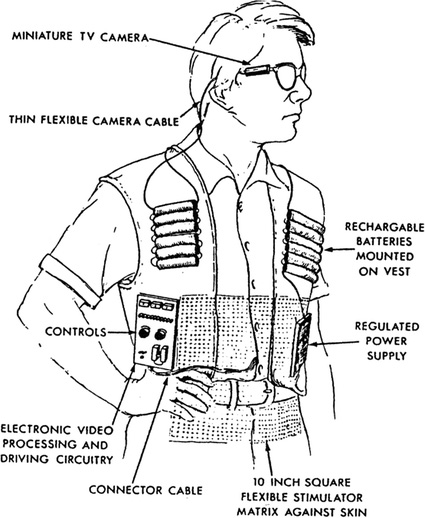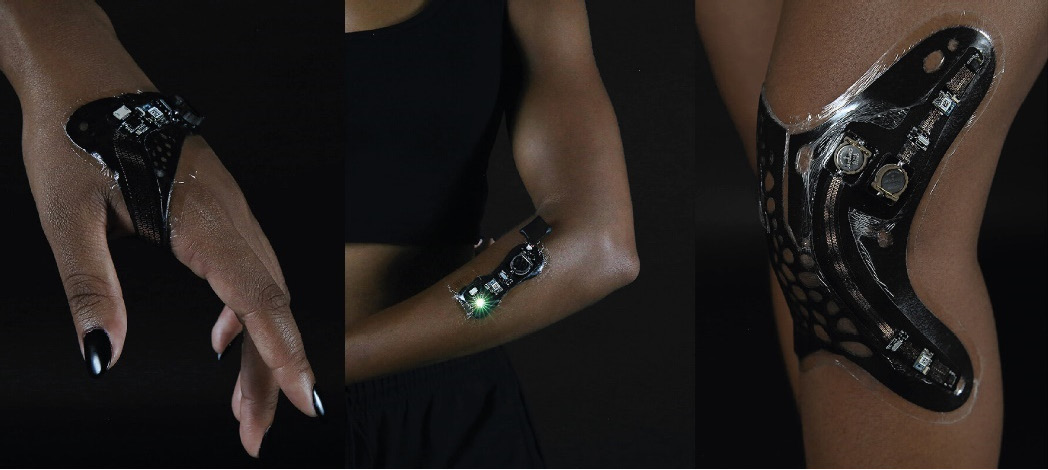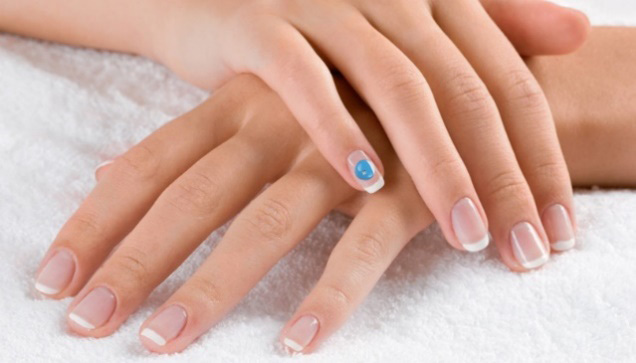Wearables definition
The definition of wearables can vary based on the field and application. Most definitions include a continuously worn device. Typically, augmenting humans for memory, communication, or a physical improvement is an aspect of a wearable. Wearables are seen as portable computing power, worn on or near the body. A wearable is in our personal space. It can be controlled by the person wearing it. I, often, interchange the term wearables with wearable technology or wearable computing. Also, because this field is very different from the traditional programming-only computer field, it can be described as a part of the physical computing field. This can include smart clothes or textiles, body-worn devices, and interactive accessories. The term encompasses a broad range of devices, and the definition grows and shifts as new technologies and techniques are created. It’s exciting!
Generally, for this book, the wearables you will be making will use the human body in some way. This could be to communicate with or support the technology in question. Typically, wearables have the following properties:
- Garment/material/accessory on or ‘near body’
- Embedded electronics
- A power source
- Inputs/outputs of some description
Inputs and outputs will be discussed in detail later in this book as they are essential for our designs. For now, we will say that input is a way to receive data or information in our system. The output is a way of relaying that information or responding in a way to that data. Often, wearables are used to gather data from the wearer, which can provide information or connect to services. Improvements in batteries, miniaturization of components, and new ways to create textiles, garments, and accessories have contributed to their popularity. Though, I’m sure when most people hear the word “wearable” they think of a watch. That’s okay, but that’s not the full story. So, although we will discuss watch-style devices, we will look at many other interesting wearables. There is so much more to the incredible products and services that companies, makers, and researchers are creating.
When were wearables created?
There are a considerable number of valuable resources online that follow a historical timeline of wearables, so I won’t cover it all here. One example is https://www.media.mit.edu/wearables/lizzy/timeline.html. A recent paper (2021) that also focuses on connected devices is available online at https://reader.elsevier.com/reader/sd/pii/S1389128621001651. I wanted to touch on some interesting thoughts and items to shake up your thinking and consideration when planning your wearables. Remember, we can use the term loosely and adapt it to the projects we are making.
One of the earliest considered wearable “computers” is considered the Chinese Abacus. This small ring has moving parts so that a person can perform calculations on their finger. There are seven rods, with seven beads on each rod. It is considered to have been created and used in the 17th century. The beads are too small to be used with fingers, so a small pin is used to move them. Since the pins that were used were worn in ladies’ hair, could this have potentially been for them? This isn’t strictly a wearable, in that it doesn’t have computing power or a programmable aspect, but we should consider the idea of making jewelry out of an abacus, an item that’s not worn and whose purpose is for calculating and combining those two aspects. Around 1907, the first wearable camera was created by the pioneer Julius Neubronner. This was for pigeon photography (an aerial photography technique). It was activated by a timing mechanism that activated the shutter. The camera was strapped to a pigeon!
In the 1960s, a computerized timing device was created to help mathematicians Edward O. Thorp and Claude Shannon win a game of roulette. A timer was hidden in the base of a shoe, under the insole, and another was hidden in a pack of cigarettes. It was designed to predict the motion of the roulette wheel. This was done using microswitches that indicated the speed of the roulette wheel. Musical tones would indicate a section of the wheel to bet on. The wearer had a miniature speaker in their ear to hear the tones that were produced.
July 1, 1979, was a day for portable music. This is when Sony created the Sony Walkman TPS-L2 (https://www.sony.com/ja/pressroom/pict_data/p_audio/1979_tpsl2.html):

Figure 1.1 – Sony Walkman
The founder of Sony, Masaru Ibuka, was searching for a way to listen to music in a portable way so that he could take music on flights with him. Prototypes were made and the Walkman was born. Over 400 million Walkman players, in all their forms, have been sold over time. Their designs became slimmer, sports versions were made, and other improvements were made to their power so that their batteries could be recharged.
You may have come across the Casio calculator watch that was launched in the 1980s, known as the C-80. This was a success and Casio followed up in 1984 with the Databank Telememo CD-40. The sales from these in the first 5 years was around six million units. Figure 1.2 shows an advertisement from Casio for the calculator watch in the 1980s.
Another original piece of smartwatch technology was the 1988 Seiko WristMac, after which came the Timex Datalink in 1994. This was co-developed with Bill Gates (Microsoft) and had a playable Invasion video game on it. Figure 1.2 shows model 150 with a steel bracelet in PC-communication mode. The Datalink was worn by astronauts during Expedition 16. It had wrist applications that they used as part of their explorations and for sending data for analysis.
A Wearable Wireless Webcam was developed in December 1994 by Steve Mann, a Canadian researcher. In 1998, Steve Mann invented, designed, and built the world’s first Linux wristwatch, which he presented at IEEE 2000. This is shown on the cover of Linux Magazine in Figure 1.2. This prototype was launched by IBM, with wireless connectivity. Steve Mann is considered one of the fathers of wearable computing, and you can read more about his decades of experience designing and wearing wearable computers at https://spectrum.ieee.org/steve-mann-my-augmediated-life:

Figure 1.2 – Left to right: an advert for the C-80 Casio watch, the Timex Datalink, and Linux Magazine
Today, you can buy a fully programmable LilyGo watch that incorporates an ESP32 chip – we will be using that chip (not the watch) in Chapter 7, Moving Forward with Circuit Design Using ESP32.
Lastly, it’s worth mentioning the crowdfunding hit, Pebble. This smartwatch supported both Android Wear and Apple Watch operating systems. Samsung Galaxy Gear was available in 2013, while Apple Watch was available in 2015.
However, in 2015, Pebble set a record with over 78,000 backers and raised over $20 million with their Kickstarter campaign. Part of this popularity was due to its battery life of 7 days, compared to the Apple Watch’s, which was around 18 hours. Also, the price point for Pebble was $99 compared to $349 for Apple Watch.
Informed wearables
What about wearables that can make a real difference in someone’s life? Informed wearables look to those around us to find inspiration and where there is a genuine need. Important contributions to wearable history were developed for hearing impaired and/or visually impaired people.
Hearing impairment
Hearables, the first electronic hearing aid, was created in 1898. Miller Reese Hutchison designed a hearing aid that used an electric current to amplify weak signals. It wasn’t until around 1913 that the first commercially manufactured hearing aids came to market. Beltone Electronics created the eyeglasses hearing aid in 1960 and started the trend of combining a way to conceal hearing aids. Danavox, a hearing aid solution company http://www.danavoxhearingaids.com/legacy/, as shown in Figure 1.3, created radio-style hearing aids that looked like radios and could be carried around:

Figure 1.3 – Eyeglass hearing aid
Following those developments, in the 1990s, an all-digital hearing aid was made. The 1990s also saw creativity emerge. These became more of a jewelry item. In 2021, deaf model Chella Man, in collaboration with Private Policy New York, created beautiful gold-plated ear cuffs that could accentuate a hearing device or cochlear implants. He explained, “I always found myself brainstorming ways to reclaim the machinery that had become a part of me.”
By 2010, Bluetooth-enabled devices started to surface, which allowed for big changes to be made in the hearing aid field. There are even apps that can connect to an iPhone for a specially designed hearing aid. The Made for iPhone (MFi) hearing device connects via Bluetooth and allows a person to control volume, audio presets, and other options.
Visual impairment
In 1977, a camera-to-tactile vest was created for visually impaired people by C.C. Collins (1977). Images were converted into a 1,024-point 10-inch square tactile grid that was on a vest, as shown in the vest’s schematic:

Figure 1.4 – Tactile vest
An updated version (2014) of a vest-style prototype is the Eyeronman device. This vibrates as it senses the environment and its obstacles and conveys that information to the wearer to help them navigate:

Figure 1.5 – Eyeronman vest (credit: Tactile Navigation Tools)
One of the medical advisors for the project, Dr J.R. Rizzo, said, “I want to build a tool that can actually get [visually impaired] people to walk around crowded environments without assistance.” They see this vest being used in other contexts too, such as for firefighters, police, and soldiers, who may have impaired vision from smoke, night use, explosions, and more.
Other advances
Other important wearables were created as far back as 1977 and include an early model of a heart rate monitor that was created by Polar Electro. This was a monitoring box with a set of electrode leads. These were attached to the chest. It was used as a training aid for the Finnish National Cross Country Ski team.
Between 1991 and 1997, at the MIT Media Lab, Rosalind Picard (Picard, R., Healey, J., 1997), along with students Steve Mann (Mann, S., 1997) and Jennifer Healey, researched data collection from Smart Clothes. These clothes monitored physiological data (Mann, S., 1996) from the wearer. The 1990s was also a time when wearables started to become commercial. Around 1997, BodyMedia commercially made wearable sensors (since acquired by Jawbone). These wearables were designed to help track and monitor for health-specific purposes. This allowed people to be proactive in monitoring their health.
These past inventions, prototypes, and investigations helped set the important and exciting foundations for the world of wearables as we see it today. This is not an exhaustive list but will help you glimpse into the areas you can research further.
With our whirlwind tour of wearable history complete, let’s look at some of the current work and research in the wearable technology field.
Current work in the field
What wearable technologies exist that you know about or have? Let’s look at recent innovations and the important role wearables play in our lives. We will learn about the current work in the field by covering the following topics:
- The traditional role of clothing
- Headsets and eyeglasses
- Current wearable markets
From around 1995 onwards, artists, researchers, and creators began questioning the traditional role of clothing. To redefine the role, Kipöz (2007) looked at clothing as a hyper-medium in risk society. Clothing was redesigned to provoke thought and discussion. Hyper-medium looks to incorporate functionality and contemporary aesthetics. Distinct areas of creation involve protection against disaster, which is the idea of protecting against the unfriendliness of the world around us. Lucy Orta’s wearable shelters were conceptualized for disaster victims, homeless people, and similar.
These garment structures became places of comfort and seclusion to meet the need for privacy and personal space. Part of the goal was to also provoke discussions regarding homelessness, place, and space. Another area of concern is the environment itself. A Metropolis Jacket with an anti-smog mask was created in 1998 to help combat the negative environmental impacts on people.
A very exciting vision (Figure 1.6) for the adaptability to use this sensor directly on the body to allow movement and comfort is ElectroDermis. As stated by Eric Markvicka, Guanyun Wange, et al., in 2019, “ElectroDermis is a fabrication system that simplifies the creation of wearable electronics that are comfortable, elastic, and fully untethered.” They recognized that “wearable electronics require structural conformity, must be comfortable for the wearer, and should be soft, elastic, and aesthetically appealing. We envision a future where electronics can be temporarily attached to the body (like bandages or party masks), but in functional and aesthetically pleasing ways”:

Figure 1.6 – ElectroDermis (photo credit: Morphing Matter Lab, Carnegie Mellon University)
One of the world’s smallest wearables fits on a fingernail and measures UV wavelengths, as shown in Figure 1.7. It interacts wirelessly with a mobile phone. Its primary use is to reduce skin cancer frequency. “We hope people with information about their UV exposure will develop healthier habits when out in the sun,” Xu said. “UV light is ubiquitous and carcinogenic. Skin cancer is the most common type of cancer worldwide. Right now, people don’t know how much UV light they are getting. This device helps you maintain an awareness and for skin cancer survivors, could also keep their dermatologists informed.” It was developed by Northwestern Medicine and Northwestern’s McCormick School of Engineering scientists. One version of it, which looks like a small wearable pin that you can clip onto your nail, is commercially available:

Figure 1.7 – UV nail sensor (photo credit: Drs. June K. Robinson and John Rogers, Northwestern University, Chicago, IL)
Headsets and glasses are also prototyped often for wearable computing. Around 1980, Steve Mann developed a series of headsets that included embedded cameras and microphones. These recorded daily activities and were cumbersome in their design due to the available technology.
The 1990s saw collaborations with Thad Starner and Steve Mann, which led to what is seen as modern-wearable computing. Typically, in the 1990s, interdisciplinary explorations began happening in research projects. Some of the research fields allowed for a more interdisciplinary approach, including design, computer science, management, fashion, electronic engineering, computer engineering, and human-computer interaction fields.
Eyeglasses contribute to what is considered an augmented human by using lenses to correct vision. An augmented human can be described as an enhancement that’s made by making a natural or technological alteration to the human body. Typically, this can be to enhance performance in some way or to add to our capabilities. Eyeglasses have been a focus for wearables since the 1990s. Most notably, a lot of this work, 10 years in the making, culminated in Google Glass being sold in 2015. Glass had privacy issues and there was a backlash against its use. Since 2015, Glass has only been available as Enterprise and not for public purchase.
However, Solos cycling smart glasses help cyclists keep their eyes on the road. This was a successful Kickstarter campaign in 2017 and is now commercially available. Solos provides important running and cycling metrics such as pace, heart rate, and power without someone having to take their eyes off the road. This was initially started as a project for the US Olympic cycling team.
Another product that was created with eyeglasses in mind was OrCam MyEye. This is a device that takes all these features further, as shown in Figure 1.8. It was designed for people with vision loss and various eye conditions, including reading fatigue or reading difficulties. OrCam has a camera that interprets a wearer’s visual information.
An example of such information could be when you’re reading a menu – it can read out, audibly to an in-ear headphone the menu items. It can also recognize faces, colors, products, money, barcodes, and similar:

Figure 1.8 – OrCam MyEye (left) and Pocket Sky (right)
It consists of a magnetically mounted device (for eyeglasses) that works in real time without any need for a smartphone or other device. At the time of writing, it costs around £4,000 to purchase, which makes it a very specialist item, as is common for many assistive technologies unfortunately. However, it is an item that could benefit a lot of people.
There are also Everysight Raptor and Ray-Ban Stories, which allow you to record videos and take photos. Lastly, there’s Amazon Echo Frames. However, it doesn’t use augmented reality – it’s used for playing Alexa feedback. This allows you to control your devices, play music, and similar.
Pocket Sky (Figure 1.8 right) acts like sunlight when not enough natural light is available. This version of the eyeglasses wearable activates and keeps a person’s sleep-wake rhythm in balance. A lack of daylight in winter can make you tired. Pocket Sky aims to lift your mood and ease seasonal blues.
When you think of wearables, what springs to mind? If you talk with someone about a “wearable,” what devices are they talking about?
Some of the successes in these technologies show that there’s a great understanding of the craftsmanship and ability to use hardware, alongside knowledge of materials and textiles. This knowledge creates a great combination of skills.
As your journey through this book progresses, you’ll learn about the hardware, the sensors, the code, and how to connect it all. You’ll also learn about important textile and fabric knowledge. This can be the difference in creating a truly usable wearable prototype.
Taking it further
If you’ve enjoyed learning about some of the current work in the field, you can look up more wondrous and futuristic designs through the work of Anouk Wipprecht, Pauline van Dongen, Iris Van Herpen, Suzanne Lee, Helen Storey, and Hussein Chalayan. These creators design within intersections of fashion, science, technology, and art to create stunning designs that offer a playful and critical look at how the human body can be transformed.
Now, let’s look at the intriguing work that’s being done in textile electronics. We’ll learn about embroidery, smart fabrics, and the sensors that are used in wearables. This will help us consider materials, fabrics, and textiles in our designs in this field.

